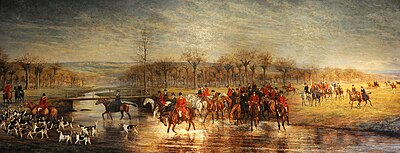The Pau Hunt was established in 1842 by the Société d’Encouragement as a spectacule authorized by the government of Louis Philippe to hunt predatory animals such as wolves and foxes.[1][2][a] Internationally, the Pau Hunt, dominated by American and British Masters, was one of the most renown hunts until the breakout of World War II. Its country, between Gardères and the hills surrounding Pau was nicknamed “Leicestershire in France”.[3]

Innovative hunt masters and committee members organized their first recorded drag hunt in 1847.[4][5] They organized the capture of game and its later release at meets as early as the 1850s, cross country matches and point-to-point races in the 1890s.[6][7][8]
In 1947 the association reorganized as the "Pau Hunt Drags".[b] Continuing its tradition of drag hunting, meets are held in unplanted fields with the expressed permission of amiable property owners.[8]
A plethora of private photos, articles, publications, photos and works of art during its heyday are housed in private collections, including the collection of the English Club of Pau.
Notes
edit- ^ The legend of the Duke of Wellington at Pau obscures the true history of the Pau Hunt.
- ^ Registered as the Société d'Encouragement Pau Hunt Drags, located at the Berlanne Kennels, Siren 78232147500017, Siret 782321475
References
edit- ^ "Pau, Séjour de LL AA RR, Le Duc et Duchesse d'Orléans" [Pau, Visit by the Duke and Dutchess of Orleans]. Le Memorial des Pyrénees (in French). Pau, France. 3 September 1839. Retrieved 15 February 2022.
- ^ "Le Nouvelles Locales" [Local news]. Le Memorial des Pyrénees (in French). Pau, France. 3 December 1842. Retrieved 15 February 2022.
- ^ St Lawrence, 4th Earl of Howth, William (1907). Leicestershire in France or the Field at Pau, translated into French by Charles Salverte. Pau: Imprimerie Vignancour.
{{cite book}}: CS1 maint: numeric names: authors list (link) - ^ One of them (18 July 1848). "Fox Hunting in the South of France". Craven's Sporting Review. London.
- ^ One of them (18 July 1848). "Fox Hunting in the South of France (Part 2)". Craven's Sporting Review. London.
- ^ "Pau Kennel Committee Meeting Minutes 1867-1885" (Document). Archives communautaire Pau Béarn Pyrénées Cote 36Z1: Pau Kennel Committee.
{{cite document}}: CS1 maint: location (link) - ^ "Pau Kennel Committee Meeting Minutes 1886-1899" (Document). Archives communautaire Pau Béarn Pyrénées Cote 36Z2: Pau Kennel Committee.
{{cite document}}: CS1 maint: location (link) - ^ a b "Pau Kennel Committee Meeting Minutes 1901-1928" (Document). Archives communautaire Pau Béarn Pyrénées Cote 36Z3: Pau Kennel Committee.
{{cite document}}: CS1 maint: location (link)